Introduction
As a matter of fact, submarines like aviation had many fathers. Although Clement Ader claimed to have “flown” his Eole in 1890, a small hop of about 50 m at 20 cm off the ground, it remained unofficial. The feat would have to wait 1903’s Wright brothers attempt. Paternity of the first submarine however made no doubt. The American inventor Bushnell and his turtle, and the first “kill” by a submarine, the CSS HL Hunley in 1864 were Americans. However on the other side of the Atlantic, in 1800 Robert Fulton created for the French the Nautilus.
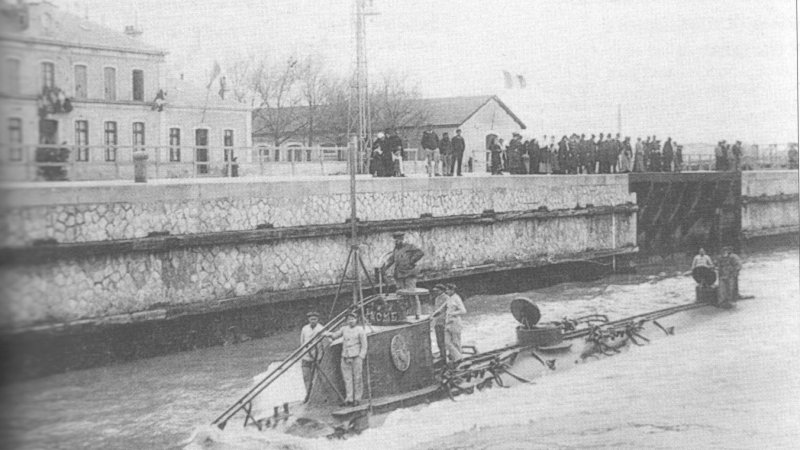
Gnome, of the Farfadet class which introduced variable-pitch propellers (cc).
The pionneers 1863-1899
If the Plongeur started an early craze about submarines, inspiring Jules Vernes‘s famous own “Nautilus” and twenty leagues under the seas (1870), the Navy remained skeptical and by the early 1880 concentrated on torpedo boats instead. The electrically-powered Gymnôte became a breakthough and relaunched the interest for undersea warfare. But for the engineers of the time, a submarine was a complex machine destined to exceptional undersea performances, and many engineers started their own design in this philosophy. It would take time after Laubeuf’s Narval before the Navy settled up on a single design.
Le Plongeur (1863)

From 1859 to 1863, engineer and Captain Siméon Bourgeois and Charles Brun, the builder, launched the Plongeur (“plunger”). The race was on, to devise the first practical submerged attack ship.
The competition was fierce however. In Spain already in 1859, Narcis Monturiol created the Ictineo, first air-independent and combustion-engine-driven submarine. And even before in 1850, for the small state flotilla of Schleswig-Holstein, Bavarian inventor and engineer Wilhelm Bauer created the Brandtaucher. It was, however, man-powered with three turning large tread wheels connected to a propeller.
“The Plunger” was started when the Conseil des Travaux in 1859 ordered naval engineers to submit plans for a submarine and selected Brun and Bourgeois concept. Le Plongeur was, by all accounts, an amazing contraption, with an hydrodynamically sound hull shape, reminiscent of early submerged ram concepts, and using compressed air which allowed four knots. Compressed air indeed powered a conventional reciprocating engine.
This air was stored into 23 tanks under 12.5 bar (1.25 MPa, 180 psi) pressure. But these tanks took up 153 m³/5,403 ft³, therefore obliged to enlarge the submarine itself, bringing its total to 381 t (420 tons) in displacement submerged, making it the largest submarine ever at that time, for decades. The final engine power was just 60 kW (80 hp), which ws just enough for a laughable 5 nmi (9 km), at 4 kn (7.2 km/h).

Compressed air being also used for emptying the ballast tanks, 53 m³ (1,872 ft³) wide, made likely a single dive be performed at each sortie. Ballast was 212 t (234 tons). The crew was 12. The deck counted a small lifeboat for exchanged at sea and to resupply the boat in air, she was followed by a support ship, the Cachalot.
The armament comprised both a traditiona, reinforced ram, and an electrically-fired spar torpedo, maintaining a safe distance before detonation. However the design was plagued by the decision of Admiral Bourgeois to ban the use of torpedoes in the Navy and the design did not evolved further.
Built at Rochefort, she made her debuts at the Charente river, then La Rochelle, La Pallice, but during these trials it was established she suffered from stability problems and could not dive further than ten meters. In 1867, Le Plongeur was disarmed but she was showcased at the Paris international exhibition. But she resumed tests and was finally discarded in 2 February 1872. She was later converted as a supply ship, an automotive water tanker in Rochefort harbour. She was rebuilt and received a new engine, and survived until 1927, was transferred to Toulon, and was eventually decommissioned in 25 December 1935.
Le Gymnote (1886)
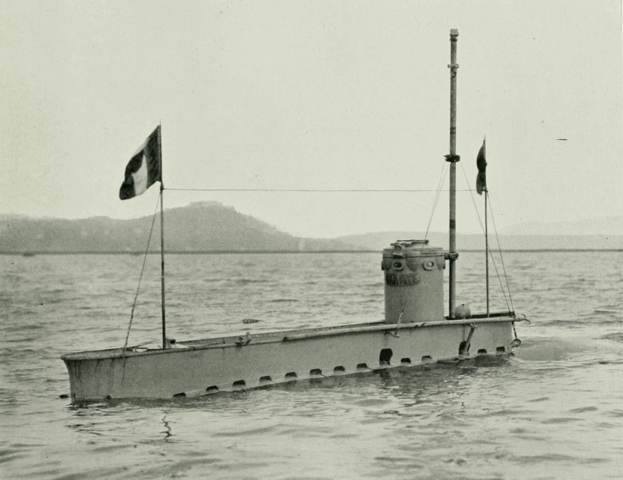
Submarine Gymnote Pages International Naval Magazine 1902 – (cc)
In 1886 France built the Gymnote, the first electrically powered submarine but also the first functional submarine equipped with torpedoes. The development of French submarines started from there, and by 1914, the French Navy has one of the most diverse and extensive fleet of submarines anywhere, and a recoignised pioneer worldwide.
This was, however, through the same Young School experimental frame of mind, a whole set of prototype models spanning the whole range of definitions a submarine should be. On the other side of the Atlantic, John Holland created a model that would be a blueprint for many Nations, including Great Britain and Japan.
The Gymnote was officially the very first active service French submarine (Q1). The Q-serie stopped with the Foudroyant (Q257) (1974). This was rather small, torpedo-shaped submarine commissioned by Admiral Aube, started by Dupyu de Lôme, but achieved by Gustave Zédé when he passed away, and when the latter died too, to Gaston Romazotti. It was designed with a small positive buoyancy in order to stay on the surface in case of power failing, and even in the case her rudders were pointing downwards.
She had three ballast tanks tested either with compressed air and electrically-operated pumps. Her initial stern rudder was a failure and she was unstable. She would received later additional rudders and became stable around 1893.
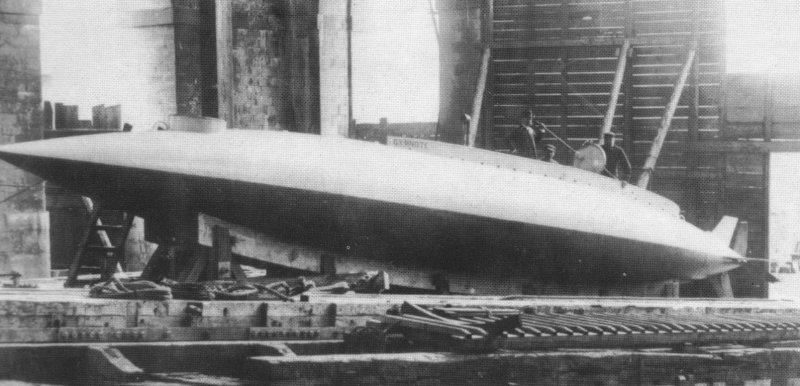
She was propelled by Le Havre Captain Krebs’s 55 horsepower (41 kW), 200V/200A engine. Compact, it was 1 metre in diameter and 2 tonnes in weight, and propelled the shaft to 250 rpm and two sets of brushes. The rear bearing was unaccessible but the hasft was designed to gradually stop spinning by itself in case of engine failure. The boat batteries counted 540 Lalande-Chaperon alkaline cells. Placed near the bow, they used Zinc and copper oxide electrodes with potassium hydroxide electrolyte.
Banks connected in different combinations provided various speeds but the entire array of batteries weighted a total of eleven tons. A new battery set was installed in 1891, changed again in 1897. The hull was 6 mm thicks at the centre, down to 4 mm on both ends, strenghtened by 31 circular frames and longitudinal bracing.
After a periscope was tested and proved unsatisfactory, or even dangerous, a small conning tower was added in 1898. Compass and a gyroscope completed the equipments as well as the two 14-inch torpedo tubes at the prow. Gymnote multiplied testings from early 1889 to 5 March 1907 when she ran aground.
She was in drydock but her hatch was not closed apparently and whe was flooded and lost when the dock was filled. Never repaired she was decommissioned and scrapped in 1908.
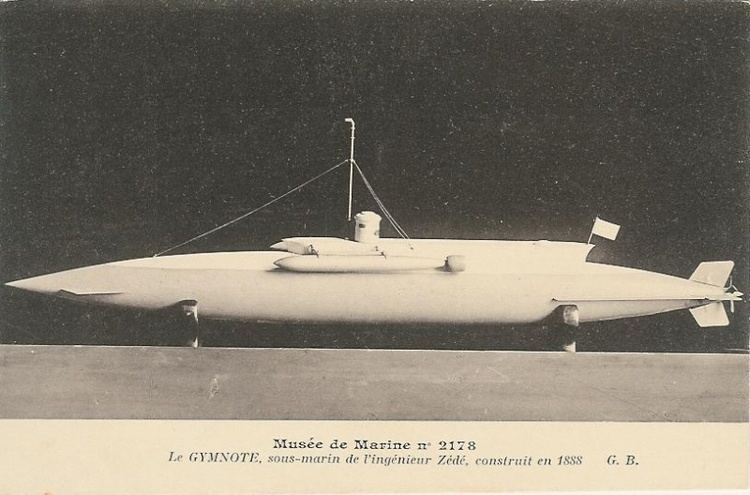
Gustave Zédé (1893)
This was one of the earliest commissioned submarines. Launched 1 July 1893 at Toulon, France, she was also one of the first to make torpedo launches in operational conditions, hitting the battleship Magenta.
Designed by engineer Romazotti from 1891 after Gustave Zédé passed out, she had been named originally Sirène. She was the seond French Navy operational submarine, Ordered on 4 October 1890, laid down on 1 February 1891, launched on 1 June 1893 and commissioned 1 May 1900.
This was basically a development of the Gymnote, but much larger. She served until 1908, multiplying dive tests and torpedo exercizes with the fleet. She was able to performe its intended role, but the choice of all-electric prevented any idea of recharging the batteries by using a conventional engine, so the range was overall limited.
Specifications:
She was 260/270 long tons surface/submerged, was 148 ft (45 m) long, 10 ft (3.0 m) in diameter, made of hull was made of bronze rather than steel to resist corrosion. This also allowed the use of a magnetic compass. The hull was reinforced by 76 longitudinal ribs, a detachable central lead keel and two centrally placed ballast tanks and trimming tanks. She also tested a manually operated diving rudder, but eventually used Hydraulic hydroplanes instead.
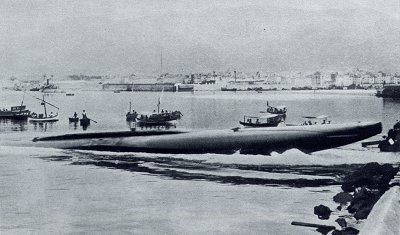
Gustave Zédé being launched in 1893
The Zédé was powered initially by 720 battery cells, an ensemble of 130 tons capable of delivering 1800A at 300V, 15 knots total on surface which was unheard of for electrical power. However the system overheated and exploded. This was then lowered to a more manageable 300 battery cells in 1895. Indeed the first system The idea was to use spares if needed. Propulsio was electric, relying on two 360 hp (268 kW) Sauter-Harlé electric motors for a surface speed of 9 knots (17 km/h; 10 mph) on the surface and 6.5 knots (12.0 km/h; 7.5 mph) submerged. She was able to dive at 50 feets;
Her nominal, and tested range was 220 nmi (410 km; 250 mi) at 5.5 knots (10.2 km/h; 6.3 mph) on the surface, reduced to 105 nmi (194 km; 121 mi) at 4.5 knots (8.3 km/h; 5.2 mph) submerged, which was far better than the Gymnote. She was armed by a single 14 in (360 mm) Fiume ‘short’ torpedo tube and two more torpedoes in surface Drzewiecki drop collars.
World Fame
In December 1898 Gustave Zédé took part in naval exercises with the Mediterranean fleet (Admiral François Fournier), and the world press was present, including the British Naval attaché. Twice the submarine successfully approached to a range of 270 yards (250 m) and torpedoed (with dummies) the French Battleship Magenta. The submarine, commanded by Lieutenant Lucian Mottez, made a first, which was widely reported in Naval circles. The submarine repeated the feat in 1899 before the minister of Marine and the press.
Morse (1899)

Morse plans by Romazzotti, 1896
The third French operational submarine (Q3) Morse (“Walrus”), was entirely designed by Romazotti from Arsenal de Cherbourg. She was an early submersible built for the French Navy and set to combine the best features of the Gymnote and Zédé. Laid down at Cherbourg (June 1897) she was launched July 1899 and commissioned in March 1900. Of single-hulled construction.
She was constructed with a special “Romabronze”, tailor-made copper alloy more flexible than steel and allowing the use of a magnetic compass. She was powered by two 284cv electric motors, connected to a single shaft, enough for 90 nautical miles surface at 4.3 knots cruise speed. Top speed was 7.25 knots (13.43 km/h; 8.34 mph) on surface and 5.5 knots (10.2 km/h; 6.3 mph) (submerged)
Based at Cherbourg she served for nine years, as in March 1909 she was involved in a collision with the British schooner Greenwich. Badly damaged it was judged technology had advanced so far her design was not that desirable anymore, and in November 1909 it was decided to decommission and stricken the boat. She was sold and broken up in 1911.
The Narval Revolution (1899)
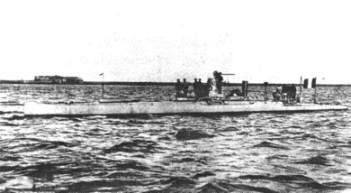
However in 1898, the ball bounced back to France again, with the Narval. Born from a fierce Navy competition with 17 submitted designs, only one, won hands down. Not only it fully respected the specifications of 100 nautical miles, speed of 12 knots, submerged range of 10 nautical at 8 knots, but Emile Laubeuf design set a new level with a revolutionary double-hull design, enclosing the rounded pressure hull, making a much more agile and faster submarine, especially on the surface.
Design
While most of its competitors concentrated (like John Holland) on building the best submarine, he took the problem on its head and conceived essentially a submersible torpedo boat. Crucially, he also clearly divided the power sources for surface and submerged propulsion. He took the same approach, but refined the concept already similar of Garrat’s Resurgam in 1878, 1880s Nordenfelt models, and even Holland’s approach with a petrol engine coupled to an electric one, with dynamos.
Laubeuf however rejected the petrol engine as too dangerous, choosing instead to adopt the 225 hp Brule steam engine with an oil-fired Temple boiler. By doing all these choices he gave his Narval a generous reserve of buoyancy, of 42%, unheard of at the time. Born from the Arsenal de Cherbourg, the Q4 was fully tested and in service by 1900. Narval’s double-hull and dual propulsion design, described as “epoch-making” made such an impression on all navies that this system was widely adopted and became the blueprint for all submarines until the German Type XXI and XXIII and Walter experiments.
She however had a serious drawback though: Her diving time was hampered by operations performed on her engines: The process included shutting down the steam boiler, cooling it down before diving to avoid residual steam to built up. The whole could take up to 21 minutes. The crew learned how to break it down to 12 minutes later but it was still a far cray to anything resembling a crash dive. Laubeuf this delay in later designs but that was the achille heal of all steam-powered submarines, solved when the diesel engine was developed.

Narval’s side view from Pages of a Canadian engineering Magazine 1902 src
Operational life
Narval started sea trials and first dive on 3 February 1900. Commissioned on 26 June 1900 she received pennant number Q4. She served actively, mostly in combined exercices and evaluations until 9 March 1909. She was stricken, but mothballed, survived WW1 unscaved and was finally sold for scrap in February 1920.
Narval was the template for more submersibles by Laubeuf, with this double-hull and dual propulsion. The “Laubeuf type” was a clear departure of other more adventurous designs, like all-eletric or petrol-driven types. This model was used and reused by the French Navy and widely copied also by all major European navies. A standard still true until the teardrop hulled nuclear submarines of the cold war.
1st era: Pre-war prototypes
Sirène class submarines (1901)
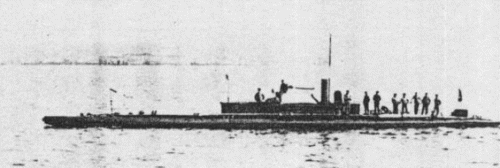
The Triton, Sirène class (1902)
This first class, first generation of french submarines were four units built on the same model in 1901, with pennant numbers Q5-6 and 13-14 (also triton, Espadon and Silure). They were essentially Laubeuf’s next design, improved versions of the revolutionary Narval. They were constructed of steel, with a double-hull, ordered on 20 May 1899 to 1st May 1900. They still were conceived as submersible topedo-boats essentially, the double hull providing both the water lest for diving and buoyancy.
Although the machinery was still like on the Narval, many improvements ensured diving time was 6 to 9 minutes, which was enough to escape many spotted ships of the time, barely making 18 knots.
Technically they displaced 157 t (155 long tons) surfaced and up to 213 t (210 long tons) when submerged. They were 32.5 m (106 ft 8 in) long, 3.9 m (12 ft 10 in) wide, and 2.5 m (8 ft 2 in) in height, propelled by 250 ihp (190 kW) triple-expansion steam engines and two 100 bhp (75 kW) total electric motors, giving a top speed, surfaced, of 9.75 knots (18.1 km/h; 11.2 mph) and 5.8 knots (10.7 km/h; 6.7 mph) when submerged. Operational range was 500 nmi (930 km; 580 mi) at 7 knots (13 km/h; 8.1 mph) reduced to 55 nmi at 3.75 knots when submerged. The crew of 13 operated also the four external 450 mm (17.7 in) Drzewiecki drop collars.
Specifications
Displacement: 157/213 t Surf/Sub
Dimensions: 32.5 x 3.9 x 2.5m
propulsion: 2 propellers, 2 TE steam engines, 2 electric mot., 250/100 hp. 9.75/5.8 knots surf/Sub
Armament: 4 Drzewiecki drop collars.
Crew: 12
Farfadet class (1901)
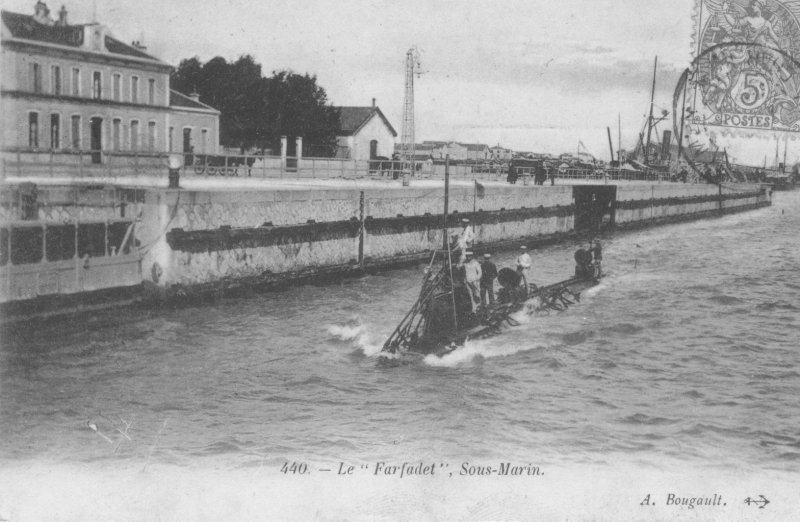
Fardadet by Bougault (cc)
These were designed by Gabriel Maugas, a French engineer at the Rochefort Naval Dockyard. These submersibles had a single-hull, and had only electric motors. So their range was quite limited and they were considered for coastal harbour defence only. Maugas however introduced variable-pitch propellers, so there was no need of a reversing engine. These four units (Q7-10) has been ordered as part of the 1899 building programme.
They were all from the naval dockyards at Rochefort; built 1901-1904. In service they were plagued by issues, Farfadet sinking during a dive in July 1905, Lutin in October 1906. Farfadet was later recovered, an enquiry followed, and she was repaired and recommissioned as Follet, in service until 1911. The other three were disarmed quickly in 1906 and converted for other tasks so they were not even in the active list in 1914.
Specifications
Displacement: 185/102 t Surf/Sub
Dimensions: 41.3 x 2.9 x 2.6m
propulsion: 1 propeller, 1 electric motor, 185 hp. 6.1/4.3 knots surf/Sub
Range: 115/28 nm at 5.3/4.3 knots surf/submerged
Armament: 4x 450 (18 in) Drzewiecki drop collars.
Crew: 16
Morse (ii) class (1901)
This class was built at Arsenal de Cherbourg in 1900-1902, of single-hull type by naval engineer Romazotti. They were the Algerien and Francais, Q-11-Q12. They were based on the previous Morse and raised by national subscription through French newspaper “Le Matin” at the time of the 1899 Fachoda incident at initial cost of 33 000 pounds at the time. They served for a short time however, as they were discarded in May 1914.
Specifications
Displacement: 147.10/160 t Surf/Sub
Dimensions: 36.7 x 2.7 x 2.8m
propulsion: 1 propeller, 1 electric motor, 307 shp. 10.1/8.3 knots surf/Sub
Range: 135/93 nm at 6/4.3 knots surf/submerged
Armament: one 450 mm (18 in) bow TT, two in Drzewiecki drop collars.
Crew: 13
Naiade class (1903)
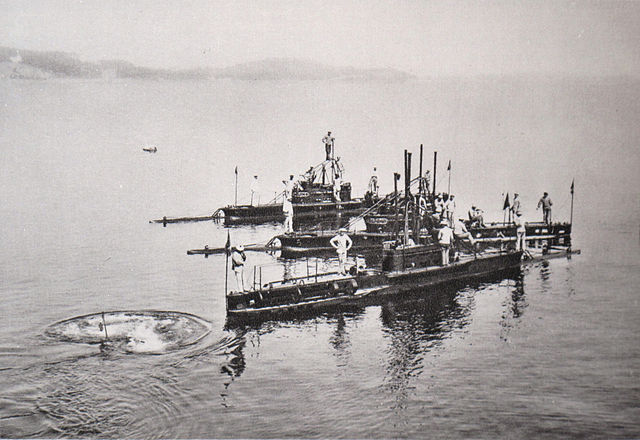
Grondin by Bougault (cc)
This was the largest class of submersibles built by France at that point. No less than twenty of them, from all three Arsenal de Toulon, Cherbourg and Rochefort. They were designed by Gaston Romazottifrom Cherbourg Naval Dockyard. Of single-hull design they introduced a dual propulsion with electric and petrol power. As previous designs by this engineer, the hull used this famous “Roma-bronze” copper alloy. The latter was more flexible than steel to offer better resistance in depht, was easier to work with, and did not interfered with magnetic compass. The surface engine was a petrol Panhard et Levassor which gave 57 bhp, but overall provided a quick dive.
The Naïades were ordered as part of the 1900 building program, at 365 000 Frs each. construction spanned five years but they remained in service only until May 1914, apart Esturgeon (stricken 1912) and Grondin (1913). Like in aviation the path of technology in this area was so fast they were considered obsolete by 1914. These submarines were small at only 70 tonnes with a crew of 12, and weakly armed with just two surface drop-collars.
Sailors nicknamed the whole serie “Fritures” or “chips”, but also “Naïade”, “Noyade” (“drowning”) by rival engineer Emile Bertin. Only one survived and was preserved, Alose, at the headquarters of COMEX maritime undersea expertise company in Marseilles. They had a better range than Romazotti boats and Farfadet class, but still paled in comparison of laubeuf’s Narval and were quite expensive.
Specifications
Displacement: 70.5/73.6 t Surf/Sub
Dimensions: 23.7 x 2.2 x 2.6m (77.11 x 7.5 x 8.6 feets.in)
propulsion: 1 propeller, 1 electric motor, 1 petrol engine, 57 bhp/95 shp. 7.2/5.8 knots surf/Sub
Range: 200/30 nm at 5.5/4.1 knots surf/submerged
Armament: Two 450 mm (18 in) torpedoes in Drzewiecki drop collars.
Crew: 12
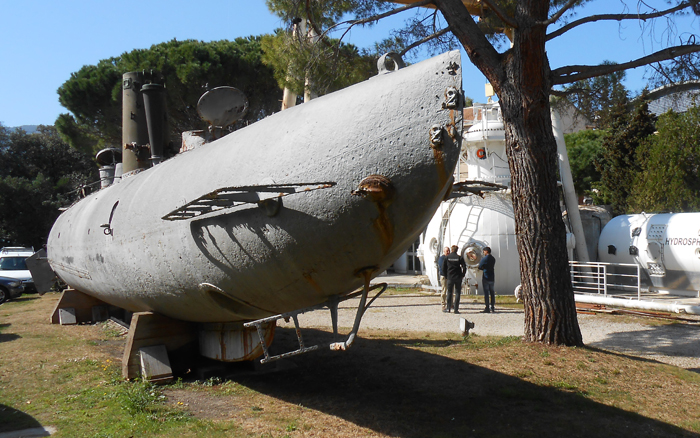
Alose preserved at COMEX (https://blueabyss.uk)
X, Y, Z prototypes (1904)
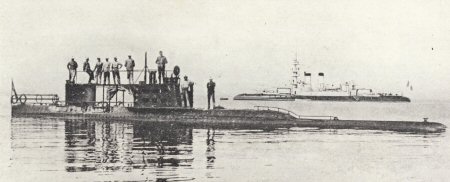
French submarine X
At that point in 1904 each yard involved in submarine construction tried to deliver a prototype, make by in-house engineer, with the idea of winning orders.
The first, X, launched in 15/11/04 at Arsenal de Cherbourg had a single hull, and was designed by Romazotti, with the same “romabronze” hull and two shafts with Panhard and Levassor petrol engine rated for 260 bhp, as compared to 230 shp for the electric motors. Top speed was about 8.4 knots in surface compared to 6 knots submerged. Armament comprised a single bow TT and three external cradles or drop collars with six torpedoes in store. She was stricken in May 1914, by then known as Dauphin.
Z was a single-hull type designed by Maugas as an improved Farfadet type and first French submarine fitted with the diesel engine. She was larger at 202/222 tons, 41 m long, but with less raw power but still 9/7 knots final. Range was also much better at 500 nm versus 168 nm. Her cost was also higher at 790,000 frs versus 500,00. She was stricken in March 1910.
Y also named Q37 from Arsenal de Toulon was designed by Emile Bertin. She was the costiest at 924,000 frs, longer at 45m for 213/226 tons, and tested a dual use diesel (for surface and dive alike), 250 bhp providing a top speed of 10 knots, 6 submerged. Technical issues arose quickly and she never completed her trials. Reconstruction projects were also dropped and she was discarded in 1909 after being launched in July 1905.
French submarines in 1914
Aigrette class (1904)
These two units from arsenal de Toulon, Aigrette and Cigogne were designed by Laubeuf, launched in january and november 1904. Still largely experimental, they were based on the Triton, with a combined diesel-electric system providing a diving time reduced to 4 minutes.
The French admiralty has not yet chosen the type to be built, and submersible Z and Aigrette were both conducted on July 18, 1904 at Cherbourg for comparison tests before a special commission. The latter was appointed to continue submersible studies. On October 1904, she suffered an accidental explosion of batteries after a leak of hydrogen.
From May 13, 1908, she was sent to Toulon to serve at the Underwater Navigation school and from November 1911 she collided with Sirocco in Brest at slow speed causing little damage. Aigrette was stationed as a guard ship for the port of Brest and Cherbourg whereas Cignogne did the same at Brindisi. In 1916, Aigrette participated in the first anti-submarine net-cutting systems testings which were successful, but never used operationally.
Eleven other bopats were planned at Toulon and Cherbourg, to be named after other marine birds, but this was cancelled.
Both units were stricken in November 1911.
Specifications
Displacement: 178/253 tonnes surface/dive
Dimensions: 35.83 x 4 x 2,63 m
Propulsion: 1 shaft diesel-electric 150/130 hp, 9.25/6.45 knots
Crew: 14
Armament: 4 x 450 mm TTs drop collars and external cradles.
Omega (1905)
Built at Arsenal de Toulon by Emile Bertin and Petithomme this was the first French twin-hull submarine. She was ordered on 21 May 1907 and completed in 1909 with half of the steam machinery fitted normally to the Pluviose class. Her single shaft propeller was mated to a steam engine with two Du temple boilers, and she was renamed Argonaute from 27 September 1910. For armament she carried two bow TTs and the usual four 450 mm in either drop-collars or trained external cradles. 6 torpedoes were carried. She was stricken in 1919.
Specifications
Displacement: 306/409 tonnes surface/dive
Dimensions: 49 x 4.2 x 2,8 m
Propulsion: 1 shaft reciprocating engine,2x Du temple Boilers, 1 electric motor 350/230 hp, 10.2/6 knots
Crew: 22
Armament: 2 bow TTs, 4x 450 mm TTs drop collars and external cradles.
Emeraude class (1906)
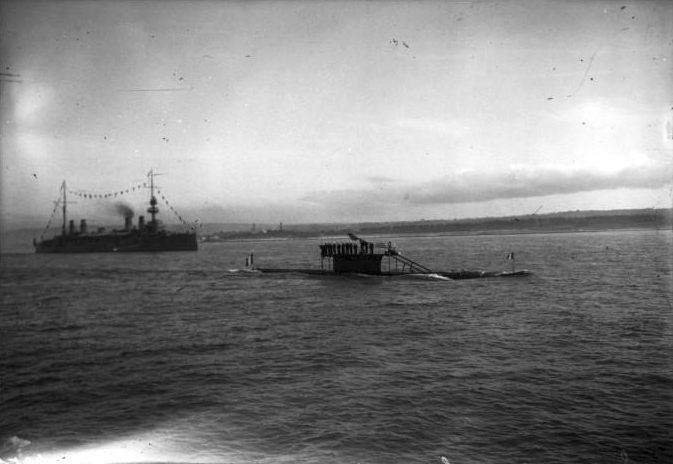
Emeraude at Cherbourg, 1909 (cc)
These famous “gems” names, carried by three generations of French submarines, started there. This class of six boats, Emeraude, Opale, Rubis, Saphir, Topase, Turquoise (Q41-46) were designed by Maugas, under the 1903 naval program. These 400 tons units started wit some good credential like two diesels and a record engine power of 600 bhp; but they were fraught with problems which delayed their completion.
Launched from August 1906 to 1908, at Arsenal de Toulon (last three) and Cherbourg, their buoyancy was poor and therefore this power was squandered in abysmal surface performances. On paper they reached 11.5 knots which was the best achieved so far. But the Sautter-Harlé diesels were riddled ith problems and defects.
Topase and Turquoise in 1915 were fitted with a 37mm QF gun, and the first was later given a lenghtened conning tower. Three fought in the Dardanelles. Turquoise was blasted by Turkish gunfire and beached to save the crew, while Saphir hit a mine and sank on 5.1.1915. Turquoise was later recovered by the Turks, integrated in the Ottoman navy as Mustadieh Ombashi but she was never fully commissioned and was returned to the french after the armistice and peace treaty. All the remainder were stricken in November 1919.

Blueprint of the Topase (plans marine nationale)
Specifications
Displacement: 392/425 tonnes surface/dive
Dimensions: 44.9 x 3.9 x 3,6 m
Propulsion: 2 shafts diesel, 2 electric motors 600/? hp, 11.5/9.2 knots
Crew: 23
Armament: 4 bow TTs, 2 stern TTs, no reloads.
Circe class (1907)
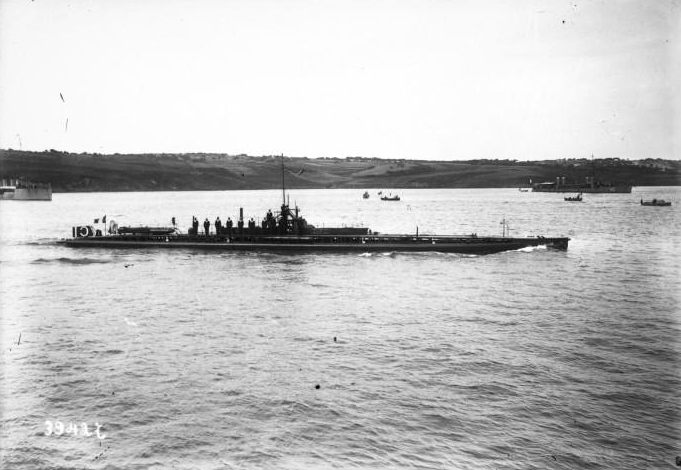
This pair of Toulon-built boats, designed by Laubeuf, were ordered in 1904 as part as this year plan. They were of the usual Laubeuf type, with reliable diesels, and were he faster of all series built so far. Calypso was sunk in a collision on 7.7 1914 with Circé, which survived and war repaired. She torpedoed the German UC 34 but was herself sunk by U-47 in the adriatic in 20.9.1918.
Also, ordered but never completed were the two Guepe (Q49 and 50) from Arsenal de Cherbourg, designed by Petithomme. Ten were planned in the 1904 program, three groups in three yards, the two first were ordered at Cherbourg in october 1904, laid down, but construction was stopped in March 1908. Subsequent pennants were allocated to the Pluviôse class, of better design.
Arsenal de Rochefort was also ordered two improved Emeraude class, also designed by Petithomme, under the same 1904 program, and construction started in the fall of 1904 and 1905 to be cancelled in 1908. They would have been named Q59 and 60, but these pennants were reallocated to Brumaire class submersibles.
On a completely different register, a small prototype also emerged, designed by Marquis de Dion, the automobile designer. This was a Goubet derivative, of the vedette submersible type (a sub MTB) to be used on a carrier cruiser like the Foudre did with “torpilleurs vedettes”, on as self-defense means on battleships. Construction started in October 1904, but cancelled and the hull was used for experiments.
Specifications
Displacement: 351/491 tonnes surface/dive
Dimensions: 47.1 x 4.9 x 3 m
Propulsion: 2 shafts MAN diesel, 2 electric motors 630/460 hp, 11.9/5.1 knots
Crew: 22
Armament: 6 torpedoes, 2 in Drzewieckli drop-collars 4 external cradles, 1x 47 mm gun
Pluviôse class (1907)
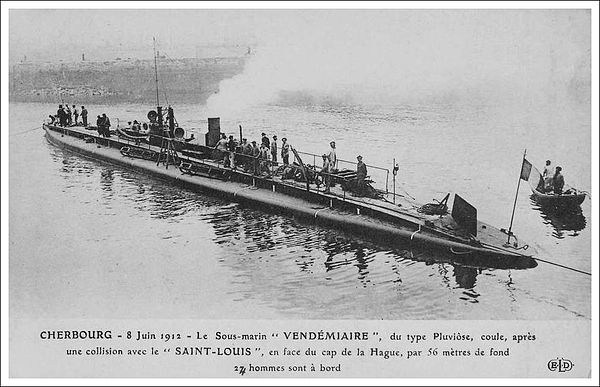
A class of 18 boats bearing the names of French engineers or revolutionary months. They were built in groups of six at Rochefort, Toulon, Cherbourg under the program of 1905. Designed by Laubeuf, equipped with a double hull they derived from the excellent Narval. They were submersible torpedo boats, equipped with nautical capacity on the surface thanks to their well-crafted hull and their steam engine, but were plagued by their very slow dive due to the complexity to switch to all-electric mode. Their torpedoes were mounted in outdoor cradles in the usual French fashion.
Operational career:
17 units were operational in 1914: The Pluviose had been lost by collision with the steamer Pas-de-Calais in 1910, but was bailed out, repaired and returned to service. This was not the case of the Vendémiaire, lost in 1912 for good, by collision with battleship Saint Louis. These units saw great service, especially in the Mediterranean. The Fresnel and Monge were torpedoed in December 1915, the Floréal was lost after a collision in 1918, as was the Prairial. The others were removed from service in 1919.
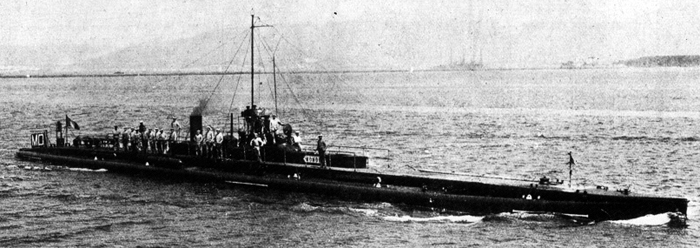

Submersible Monge (Top 1918) (cc)
Specifications
Displacement: 398/550 tonnes surface/plongée
Dimensions: 51,7 x 5 x 3 m
Propulsion: 2 shafts, 2 steam engines, 2 Du Temple boilers, 2 elect. engines. 700/450 cv, 12/8 knots.
Crew: 24
Armament: One TT 450 mm prow, 6 external Drzewiecki drop collars.
Brumaire class (1911)
Author’s illustration of the Brumaire
Second series of submersibles designed by Laubeuf, after the Pluviose, these 16 units also had names of revolutionary months and men and women of French science. They were very similar in all respects to the Pluviose type, but used MAN diesels adapted by each of the yards that had these ships in command. Thanks to this formula, they dive much more quickly. Some received 75 or 47 mm deck guns, and almost all after.
Operational career:
Their career was very active, the Bernouilli, the Foucault and the Joule being sunk (mines, collision, blow to the goal of a destroyer). The Curie was captured while attempting to force Pola’s harbor and misguided in protective nets.
She was captured, rearmed with a 88 mm and reassigned to the Austrian Navy as U14. The others were dropped from the lists between 1919 and 1930.
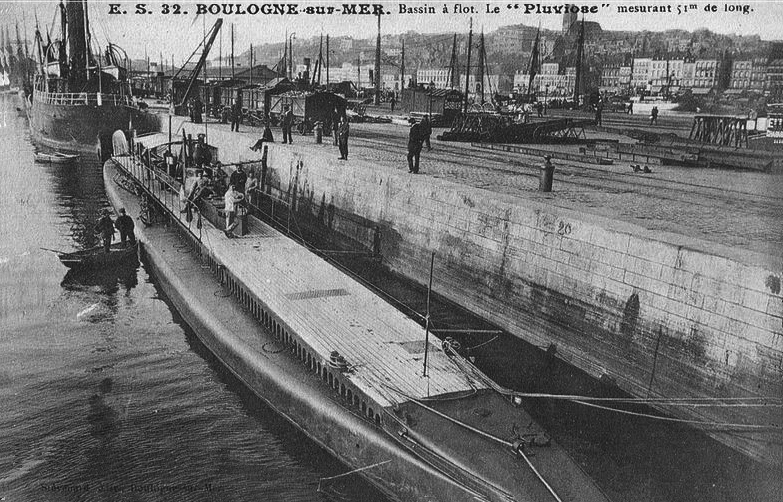
Pluviôse in Boulogne (Q51) (cc) ELD editors (Eugène Le Deley).

Blueprints of the Vendemiaire (Archiives Plans Marine Nationale)
Specifications
Displacement: 397/551 tons surface/dive
Dimensions: 52,1 x 5,14 x 3,1 m
Propulsion: 2 shafts diesel-electric 6 cyl. MAN, 840/600 hp, 13/8,8 knots
Crew: 29
Armament: 1 bow TT, 8 x 450 mm drop-collars.
Other prototypes (1909-1912)
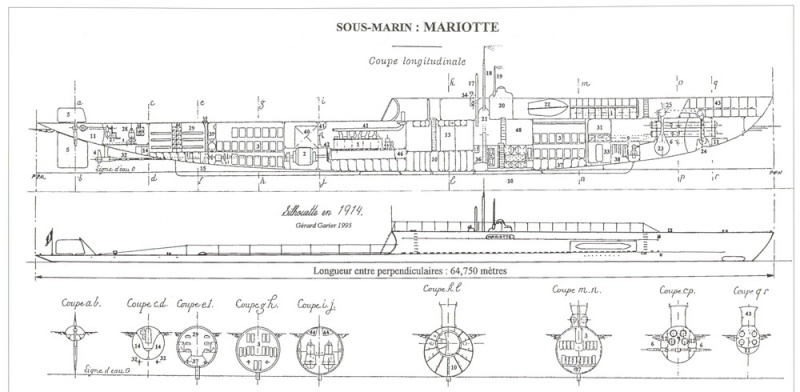
Four other submersibles were ordered from various yards to replace the current generation of the Brumaire and Pluviôse types. Although experimental, they tested power solution and seved active ly during the war.
-The first was Archimède (1909) from Cherbourg, designed by M.H Hutter, as an extended and improved Pluviôse with a twin hull. Part of the 1906 program, she had a much better machinery, with two shaft reciprocating steam engines fed by two boilers and electric motors for a total of 1700 ihp/1230 shp, figures never seen before. Therefore Archimède was capable of 15 knots in surface, 10.95 submerged. She was able to reach 100 nautical miles at 4.5 knots. Armament was the same as Brumaire. She also boasted three horizontal rudders and one vertical. During her time, she sank four transports and was stricken in November 1919.
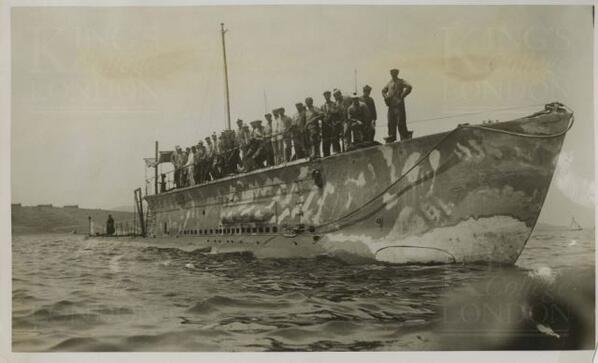
-The second was Mariotte. A rather large unit at 630 tons submerged, she was single-hulled, and designed by Radiguer as an improved Emeraude design. her solution for more power was a combination of Sautter-Harlé diesels 6-cylindr, 4-stroke units plus electric motors for a total of 1400/1000 hp. This gave them a 14.26 knots in surface speed and almost 12 when submerged. She was also modified with buoyancy tanks moved forward to improve sea-keeping. She was sunk in the Dardanelles in july 1915 after being caught in a Turkish net and fired upon.
-The third was Amiral Bourgeois. A 730 tons submersible (when submerged), she was built at Arsenal de Rochefort and launched in November 1912. Designed by Mr. Bourdelle, she had a twin-hull, and served with the Channel fleet during WW1. She ws propelled by f-stroke Schneider diesels for 1400/1000 hp and was able to reach 1385 knots when surfaced and 8.6 submerged. She had four 450 mm torpedo tubes, two after and two forward.
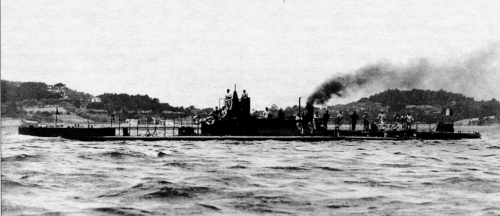
-The fourth was Charles Brun. Built at Arsenal de Toulon and launched on September 1910, she never really entered service and wa condemned in 1920. She was built to test a new all-electric propulsion system comprising two Schneider accumulators and alternators for a total of 1300 shp. Speed was 13.5/7.25 knots. She was armed with two bow TTs and four drop-collars and external cradles.
Clorinde class (1913)

Author’s illustration of the Clorinde
These two units (Clorinde and Cornélie) were ordered in 1912 (program of 1909) and launched in 1913. Of the Laubeuf type, double hull, they derived from “Brumaire” of 1912 and inspired the “Amphitrite” of 1915, although suffering poor performance. At that time, France was still refractory to standard torpedo tubes used in other fleets except in Russia, adopting the same side cradles/drop collars system developed by Russian-Polish engineer Stefan Drzewiecki. Both units served in the Atlantic and were reformed in 1926.

Specifications
Displacement: 413/567 tonnes surface/dive
Dimensions: 54 x 5,1 x 3,4 m
Propulsion: 2 shafts diesel-electric MAN-Loire, 800/700 hp, 13/9 knots
Crew: 29
Armament: 1 deck 75 mm gun, 8 x 450 mm TTs drop collars.
Wartime French submarines
Gustave Zédé class (1913)
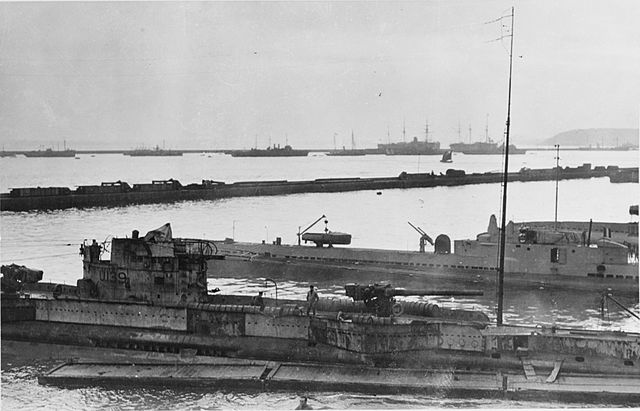
Gustave Zédé and Halbronn on the first rank
This class of two boats was ordered under the 1911 plan, designed by Simonot at Arsenal de Cherbourg. Gustave Zédé was launched 20.5.13 and Néréide on 9.5.14. Both differed in propulsion, the first was steam-drive while the second had diesels motors which lacked power. Original were teir two deck-mounted QF 65 mm guns.
Both displaced 1000 tons submerged, with diverging performances: The first one was 3500 bhp strong in surface, 1640 submerged, about 17.57 knots in surface for 11.4 submerged. The second was 2400 bhp strong with a couple of Schneider-Carel diesels which were sold at 4800 hp but could only deliver half, with as a result a top speed of 17.3 knots surfaced and 10.5 submerged but a far better range with 3120 nm versus 1400 on the Zédé.
Both served actively during the war, the first in the adriatic and the second in the Atlantic, and were rebuilt after it. Zédé in 1921-22 with German MAN diesels straight from U-165, 2400 bhp for 15 knots, new replacement bridge, conning tower and additional fuel, while Néréide received a new bridge with more vents for faster dive, and twin revolving periscopes of a new type. They were stricken in 1935-37.

Author’s profile of the Zédé
Specifications
Displacement: 850/1098 tonnes surface/dive
Dimensions: 74 x 6 x 3.7 m
Propulsion: See notes
Crew: 47
Armament: 2 deck 65 mm guns or 1x 75mm, 1x 47mm, 8 x 450 mm TTs bow, inboard, cradle.
Amphitrite class
Eight boats from Toulon, Cherbourg and Rochefort, designed by Hutter as improved Clorinde. They were launched from june 1914 to April 1916, named Amphitrite, Amarante, Andromaque, Aréthuse, Ariane, Artémis, Astrée and Atalante. Armament was the same as the Clorinde. Astrée and Amarante were completed in Le havre as minelayer submarines in 1918, the first with the Normand-fenaux system.
They displaced more, 440/610 tons and renamed with the addition of “II” when their names were reused on new units. Amarante participated in hydrophone tests, and Ariane was the only one sank, by UC-22. They were stricken from 1928 to 1935.

Author’s profile of the Amphitrite
Specifications
Displacement: 414/609 tonnes surface/dive
Dimensions: 53.9 x 5.4 x 3.3 m
Propulsion: 2 shafts diesel-electric MAN-Schneider, 800/700 hp, 12/13 knots
Crew: 29
Armament: 1 deck 75 mm gun, 8 x 450 mm TTs drop collars.
Bellone class (1914)
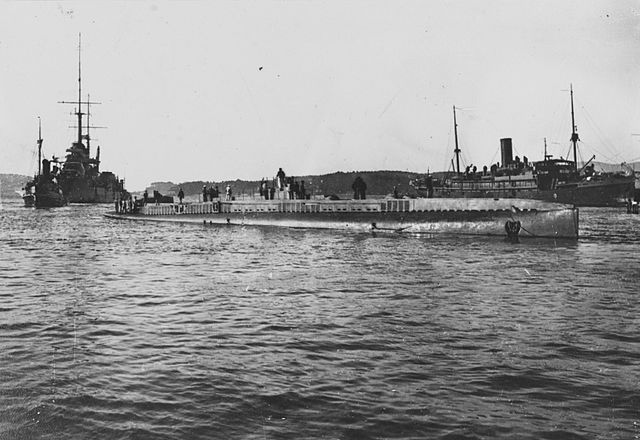
An unidentified bellone class submarine in Toulon during the war, possibly departing for the Adriatic
Three boats designed by Hutter under the program 1912 were from arsenal de Rochefort (Bellone), and Toulon (Gorgone and Hermione) launched in december 1915 and march 1917. They were twin-hulled but of coastal type, with eight 450 mm TTs in various places, bow, cradle and drop-collars. They were slightly improved Clorinde-class, Bellone served in the Atlantic and the two others in the adriatic. They were improved after the war for faster dives, with new periscopes and were all discarded in july 1935.
Specifications
Displacement: 523/788 tonnes surface/dive
Dimensions: 60.6 x 5,4 x 3,5 m
Propulsion: 2 shafts diesel-electric Sabaté/Sulzer, 1640/800 hp, 14.7/9 knots
Crew: 38
Armament: 8 x450 mm TTs, 1x 75 mm QF deck gun
Dupuy de Lôme class (1915)
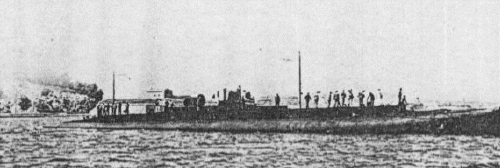
This class was authorized under the 1913 program, designed by Hutter and built at the arsenal de Toulon. This was an enlarged version of the Archimede, generally regarded as a good design, the largest and fastest submarine on record. They had a greater buuoyancy and the same machines as Zédé, two Delaunay-Belleville reciprocating steam engines fed by two return-flame Du Temple boilers, and electric motors for a generous 3500 ihp/1640 shp power, and 17/11 knots/ Range was 2350 nm at 10 knots and 120 nm submerged.
On trials, De Lôme even reached 19 knots, which was unheard of for a French submarine at that time. Both served until the end of the war with the Morocco flotilla at Gibraltar. They were reconstructed in the interwar, with a new 1200 bhp diesel, Krupp and Körting, anf followed the same line of modernisation as Zédé. Both were stricken in July 1935.
Specifications
Displacement: 833/1287 tonnes surface/dive
Dimensions: 75 x 6.4 x 3,6 m
Propulsion: 2 shafts steam-electric, 3500/1640 hp, 17/13 knots
Crew: 43
Armament: 1 deck 75 mm gun/2 and/or 47 mm, 8 x 450 mm TTs drop collars.
Diane class (1915)
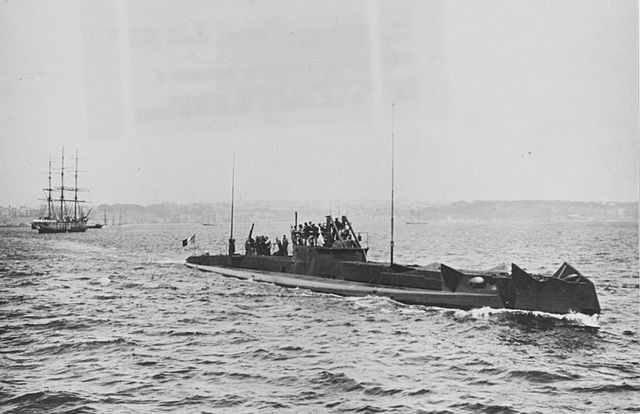
Designed by Mr. Simonot under the 1912 program, these Cherbourg-built, twin-hulled submarines were of the Archimede type. They also derved from Zédé, as a slightly more compact version, at 90%. gaining some agility in the process. They were better performers than the Bellone also. Both served during the war, Diane being sunk by an accidental explosion at La pallice, Southern France in January 1918. Daphné after the war was modernised like the Bellone class and stricken in 1935.

Author’s profile of the Diane
Specifications
Displacement: 633/891 tonnes surface/dive
Dimensions: 68 x 5,5 x 3,7 m
Propulsion: 2 shafts Vickers/Sulzer 4-stroke diesels, Electric motors, 1800/1400 hp, 17/11.5 knots
Crew: 43
Armament: 1 deck 75 mm gun, 10 x 450 mm TTs bow, drop collars and external cradles.
Joessel class (1917)
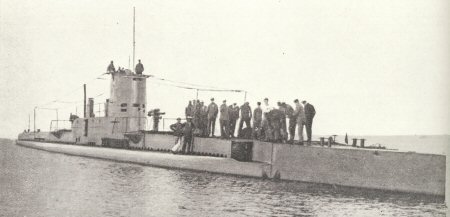
This pair was also built at Cherbourg, designed by Simonot as steam submarines to achieve great surface speeds with two geared turbines. This was a first but caused many engineering problems and the solution was scrapped in favor of a pair of Schneider-Carel diesels instead during construction.
Fulton (Q110) was launched 1.4.1917 while Joessel (Q109) was launched 21.7.1917. The turbines were recycled in the sloop Aigrette. On sea trials both subs achieved 17.5 knots. After completion they received further modifications dictated by wartime experience, like a new high conning tower, new bridge and periscopes. They served at the end of WW1 and the interwar, until stricken like all these generations boats in July 1935. A second serie was ordered at Cherbourg, Toulon and Rochefort, six boats of the same design under the 1915 program. They were planned to be laid down on May 1915 but cancelled.
Specifications
Displacement: 870/1247 tonnes surface/dive
Dimensions: 74 x 6,4 x 3,6 m
Propulsion: 2 shafts diesel-electric Schneider-Carel, 2700/1640 hp, 16.5/11 knots
Crew: 53
Armament: 2 deck 75 mm guns, 10 x 450 mm TTs drop collars, bow, ext. cradles.
Lagrange class (1917)
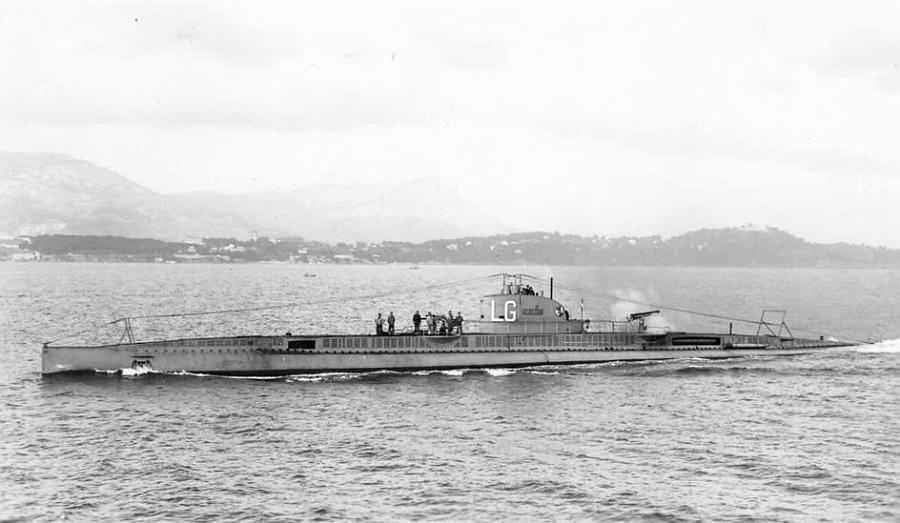
These four submarines, Lagrange, Laplace, Regnault and Romazotti (Q112-114) were designed by M. Hutter under the 1913 and 1914 programs. They were launched at Toulon (Lagrange 31.5.17, Regnault 25.6.24, Romazotti 31.3.18) while Regnault was launhed at Rochefort 12.8.19. Needless to say, they all missed the war but Lagrange (completed Feb. 1918). Plans to have then steam-powered were scrapped as they were also completed with diesels. Their Parsons turbines were recycled into the marne sloops. Postwar they were reconstructed totally and served until 1937.

Author’s profile of the Lagrange
Specifications
Displacement: 920/1318 tonnes surface/dive
Dimensions: 75.2 x 6,3 x 3,6 m
Propulsion: 2 shafts diesel-electric Sulzer, 2600/1640 hp, 16.5/11 knots
Range: 4300 @ 10 knots surface, 125 nm @ 5 knots submerged
Crew: 47
Armament: 2 deck 75 mm guns (440 rds), 8 x 450 mm TTs, 10 torpedoes.
Armide class (1916)
These were basically requisitioned submarines ordered by foreign countries when the war broke out. All three were built at Schneider, Chalons-sur-Saone. One was ex-Japanese, the others Greeks. They were renamed Amazone, Antigone and Armide (pennant SD1-3), launched 1915 and 1916. These were double-hulled Laubeuf type, with Schneider-Carel diesels, four to six TTs, one 47 or 75 mm gun. They served during WW1 and the interwar, stricken 1932-35.

Author’s profile of the Armide
Specifications
Displacement: 457/670 tonnes surface/dive
Dimensions: 56.2 x 5,2 x 3 m
Propulsion: 2 shafts diesel-electric Schneider-Carel, 2200/900 hp, 17.4/13 knots
Crew: 31
Armament: See notes
O’Byrne class (1919)
Technically they were ordered under the 1915 program and started during wartime, so these entries belongs to this page. All three were being built at Schneider (Chalons) for the Rumanian Navy. They were double-hulled Laubeuf types, like the above, but smaller and slower. Launch dates were 30.9.19 (Henri Fournier), 6.20? (Dupetit-Thouars), 22.5.19 (O’Byrne). They were discarded in 1935.
Specifications
Displacement: 342/513 tonnes surface/dive
Dimensions: 52.4 x 4,7 x 2,7 m
Propulsion: 2 shafts diesel-electric Schneider-Carel, 1020/400 hp, 14/8 knots
Crew: 25
Armament: 1 deck 47 mm gun, 4 x 450 mm TTs bow.
Maurice Callot (1921)
This single unit was built at FC de la Gironde Bordeaux. This was an experimental minelaying type, with the Normand-fenaux system, but originally a laubeuf-type system, double-hulled. Never registered a Q name. Laid down in May 1917 but only launched 26.3.21 due to shortages. She was discarded in 1936, so only served in peacetime during the interwar.
Specifications
Displacement: 931/1298 tonnes surface/dive
Dimensions: 75.5 x 6,7 x 3,5 m
Propulsion: 2 shafts diesel-electric Schneider 2-stroke, 2900/1640 hp, 16.5/10.5 knots
Crew: 48
Armament: 1 deck 75 mm gun, 6 x 450 mm TTs (4 bow, 2 stern, 8T), 27 mines.
Pierre Chailley (1921)
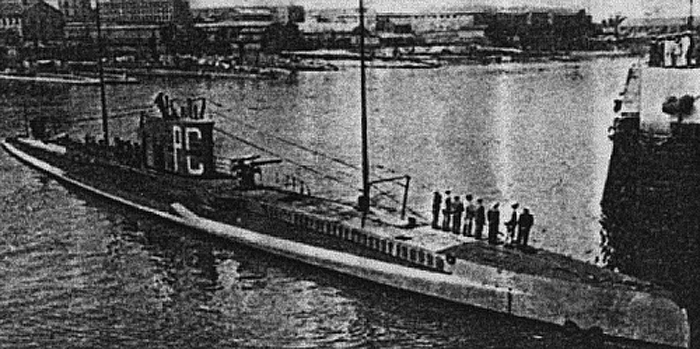
Pierre Chailley – Aldo Fraccaroli Col. (cc)
This single large minelayer type was provided under the 1917 program, built atNormand, Le havre, never gave a Q number. Double-hulled Laubeuf type she was fitted with the Norand-fenaux system sibce the beginning and was large enough to carry and laid 40 mines. This was the prototype for the successful class Saphir of 1928. The Normand-Fenaux system used a simple and reliable system where mines were located in vertical wells along the ballast hull. Smaller than the Callot they were also less powerful and slower but carried more mines, but of the smaller 200kgs/441Ib type so the whole package was ultimately more appealing. First French submarine also to be fitted with a 100mm deck gun.
Specifications
Displacement: 884/1191 tonnes surface/dive
Dimensions: 70 x 7,5 x 4 m
Propulsion: 2 shafts diesel-electric Schneider 2-stroke, 1800/1400 hp, 13.7/8.5 knots
Crew: 44
Armament: 1 deck 100 mm gun, 4x 450 mm TTs (4 bow, 2 trainable), 40 mines.
Captured french submarines of WW1
For some time, the French Navy captured and operated the Greek submarines Delphin and Xiphias in 1916-17, returned to the Greeks in 1918. UB26 scuttled off Le havre was also recovered and repaired, to serve as Roland Morillot from 30.8.17. She was discarded in 1925. After the war, many German submarines were commissioned under the French flag. Ten were commissioned in 1918, such as the renamed Victor Reveille, (U79), Jean Auric (U 108), or René Audry (U 119). 36 more German U-boats were also awarded to the French after peace negociations. For the full record, see the WW2 French submarine section.
Sources
Conway’s all the world’s fighting ships 1906-1921
List of French submarines
French submarine Plongeur
On battleships-cruisers.co.uk 1
On battleships-cruisers.co.uk 2
French submarine Gymnote (Q1)
modelist-konstruktor.org: underwater-ships-against-submarine-ships
Farfadet-submarine-disaster 1905
hisutton.com about the Narval



 Latest Facebook Entry -
Latest Facebook Entry -  X(Tweeter) Naval Encyclopedia's deck archive
X(Tweeter) Naval Encyclopedia's deck archive Instagram (@navalencyc)
Instagram (@navalencyc)





 French Navy
French Navy Royal Navy
Royal Navy Russian Navy
Russian Navy Armada Espanola
Armada Espanola Austrian Navy
Austrian Navy K.u.K. Kriegsmarine
K.u.K. Kriegsmarine Dansk Marine
Dansk Marine Nautiko Hellenon
Nautiko Hellenon Koninklije Marine 1870
Koninklije Marine 1870 Marinha do Brasil
Marinha do Brasil Osmanlı Donanması
Osmanlı Donanması Marina Do Peru
Marina Do Peru Marinha do Portugal
Marinha do Portugal Regia Marina 1870
Regia Marina 1870 Nihhon Kaigun 1870
Nihhon Kaigun 1870 Preußische Marine 1870
Preußische Marine 1870 Russkiy Flot 1870
Russkiy Flot 1870 Svenska marinen
Svenska marinen Søværnet
Søværnet Union Navy
Union Navy Confederate Navy
Confederate Navy Armada de Argentina
Armada de Argentina Imperial Chinese Navy
Imperial Chinese Navy Marinha do Portugal
Marinha do Portugal Mexico
Mexico Kaiserliche Marine
Kaiserliche Marine 1898 US Navy
1898 US Navy Sovietskiy Flot
Sovietskiy Flot Royal Canadian Navy
Royal Canadian Navy Royal Australian Navy
Royal Australian Navy RNZN Fleet
RNZN Fleet Chinese Navy 1937
Chinese Navy 1937 Kriegsmarine
Kriegsmarine Chilean Navy
Chilean Navy Danish Navy
Danish Navy Finnish Navy
Finnish Navy Hellenic Navy
Hellenic Navy Polish Navy
Polish Navy Romanian Navy
Romanian Navy Turkish Navy
Turkish Navy Royal Yugoslav Navy
Royal Yugoslav Navy Royal Thai Navy
Royal Thai Navy Minor Navies
Minor Navies Albania
Albania Austria
Austria Belgium
Belgium Columbia
Columbia Costa Rica
Costa Rica Cuba
Cuba Czechoslovakia
Czechoslovakia Dominican Republic
Dominican Republic Haiti
Haiti Hungary
Hungary Honduras
Honduras Estonia
Estonia Iceland
Iceland Eire
Eire Equador
Equador Iran
Iran Iraq
Iraq Latvia
Latvia Liberia
Liberia Lithuania
Lithuania Mandchukuo
Mandchukuo Morocco
Morocco Nicaragua
Nicaragua Persia
Persia San Salvador
San Salvador Sarawak
Sarawak Uruguay
Uruguay Venezuela
Venezuela Zanzibar
Zanzibar Warsaw Pact Navies
Warsaw Pact Navies Bulgaria
Bulgaria Hungary
Hungary

 Bundesmarine
Bundesmarine Dutch Navy
Dutch Navy Hellenic Navy
Hellenic Navy Marina Militare
Marina Militare Yugoslav Navy
Yugoslav Navy Chinese Navy
Chinese Navy Indian Navy
Indian Navy Indonesian Navy
Indonesian Navy JMSDF
JMSDF North Korean Navy
North Korean Navy Pakistani Navy
Pakistani Navy Philippines Navy
Philippines Navy ROKN
ROKN Rep. of Singapore Navy
Rep. of Singapore Navy Taiwanese Navy
Taiwanese Navy IDF Navy
IDF Navy Saudi Navy
Saudi Navy Royal New Zealand Navy
Royal New Zealand Navy Egyptian Navy
Egyptian Navy South African Navy
South African Navy






























 Ukrainian Navy
Ukrainian Navy dbodesign
dbodesign
Attempting to find information about two subs built for Latvia 🇱🇻 in the rveearly 20’s. Built at LaHavre. My father was first officer on one l and was sent to over see the construction, this was for about 4yrs. The French also built a destroyer and 4 mine sweepers. His nam was
Voldemars Jakobs Zebergs. Served on the ship “Spidola “ the sister was “Ronis “. That’s unfortunately all I have.
Hello Uldis,
Nice way to relate naval archives to personal history.
According to my bible, Conways, Ronis and Spidola were from AC de la loire, Nantes and Augustin Normand respectively, launched July and October 1926, 390/514 tons, 55×4.80×3.60 m, 2 shafts Sulzer diesels and 2 electric motors, 1300/700 bhp, 14/9 knots, and 19 tons of oil. They were armed by six 450 mm TTs, 4 bow and 2 stern, and one deck 75mm plus two MGs. The crew comprised 27 officers and sailors. I will do an overview of all three Baltic states navies this year and will go further in detail.
Cheers ! – David
My dad was stationed Toulon, Arsenal 1916-1920
Navy electrician. It say’s on his Navy hat ADMIRAL-TREHOURT (sub depo ship)
Looking for photos men ships that period. Same name as mine.
George Stell
Hello George,
It was indeed a former Bouvines class ship, a 1892 coastal ironclad, obsolete and reconverted in ww1. Her name was Amiral Tréhouart (not trehourt). She had two funnels (Bouvines had one) and spent the war as a submarine depot ship and sold fros crap in 1922. I have photos of the ship but not of the crew, sorry. All photos archives should be under the umbrella of the local Centre historique des archives: Archives de la marine en Méditerranée et dans l’océan Indien.
This source should be useful as well: https://www.rfgenealogie.com/s-informer/infos/archives/archives-nationales-les-dossiers-du-personnel-de-la-marine
Best,
David
How many enemy ships were trpedoed by French submarines durig WWI?
Since the only hostile fleets were locked up, the Austro-Hungarian in the Adriatic and the Ottoman turk one beyond the Bosporus, probably a very few and i had found so far no stats or records on this. You’ll have to dig into forum’s logs to find crew reports of claimed kills.